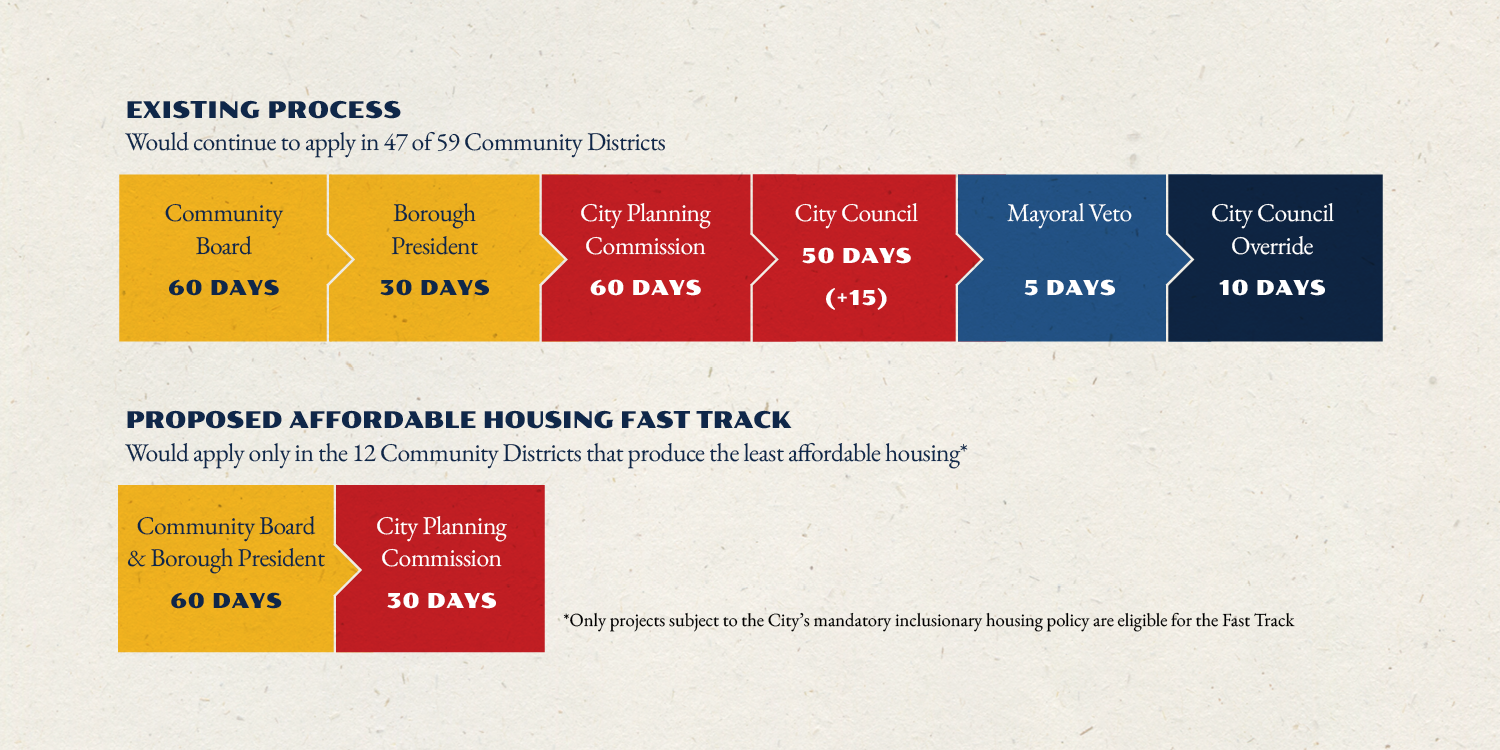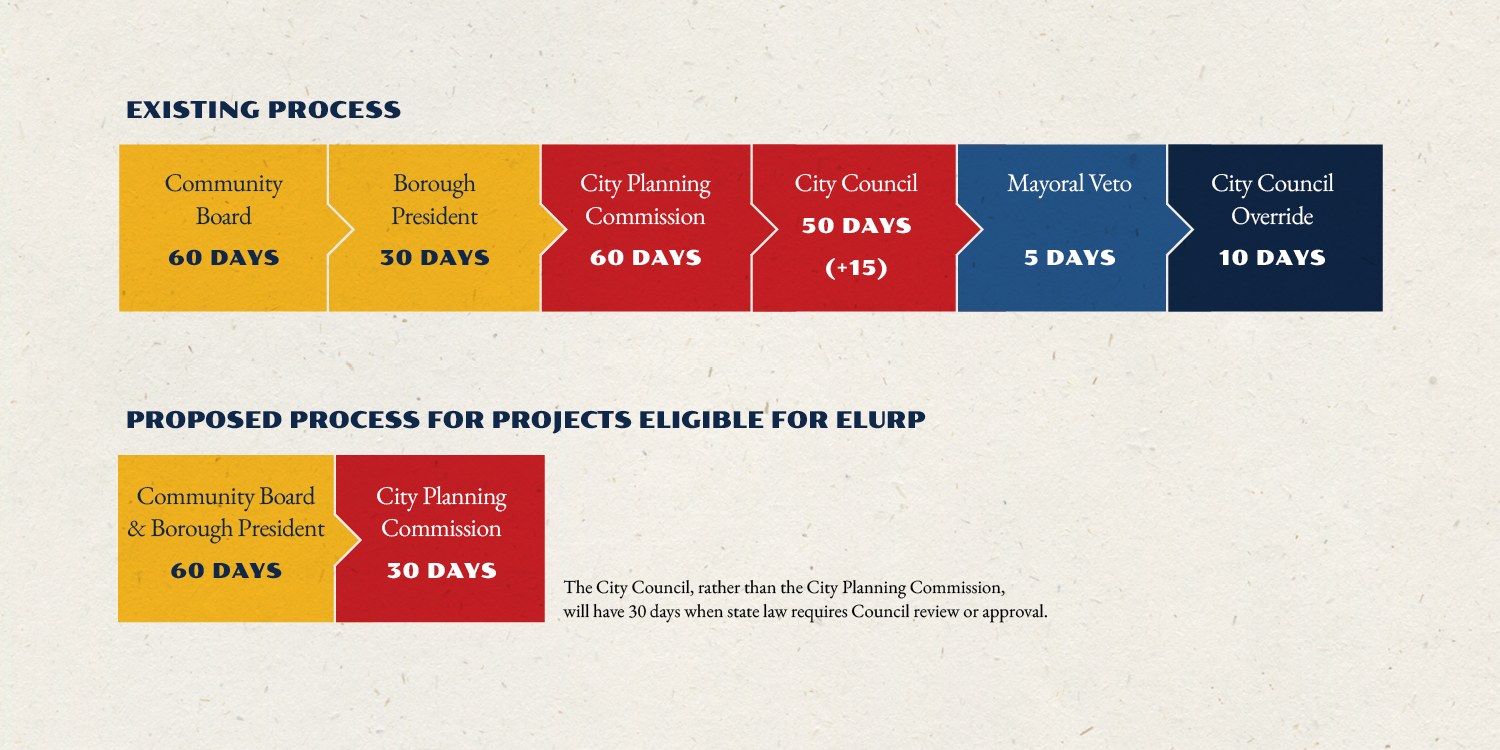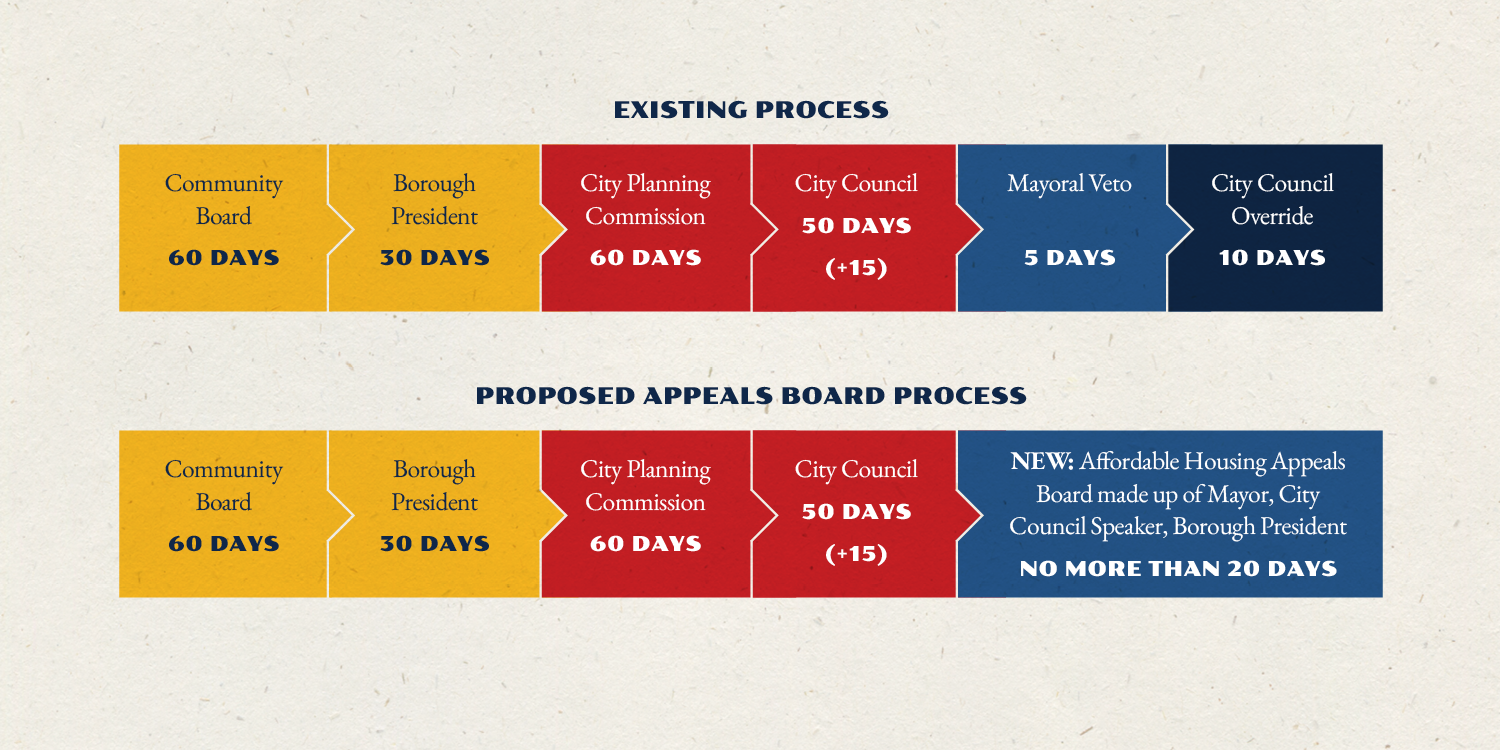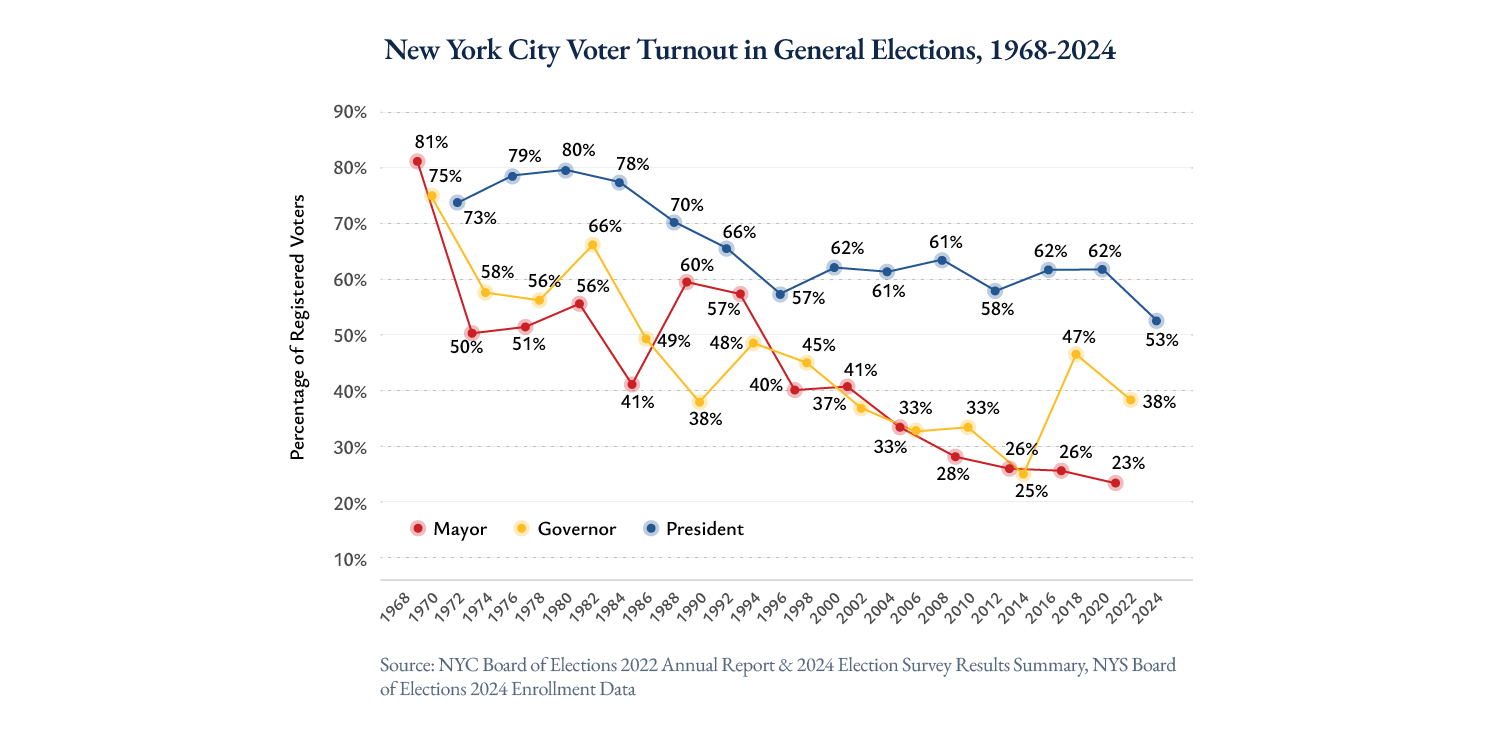
Goal: Build Affordable Housing More Quickly and at Lower Cost, and Ensure That Every Community Adds Affordable Housing
What you'll see on the ballot: Fast track publicly financed affordable housing. Fast track applications delivering affordable housing in the community districts that produce the least affordable housing, significantly reducing review time. Maintain Community Board review.
“Yes” fast tracks applications at the Board of Standards and Appeals or City Planning Commission.
“No” leaves affordable housing subject to longer review and final decision at City Council.

New York City faces what may be the worst housing affordability crisis in its history. New Yorkers feel this crisis every day, whether they are struggling to pay rent, looking for a new home for a growing family, or saying goodbye to a loved one leaving the city.
Today, the process for creating new affordable housing is long, costly, and unpredictable, especially for affordable housing supported by City funds. The result is that too little affordable housing is built. And when it is built, it’s concentrated in a few neighborhoods, with most of the city remaining unaffordable.
To address this, Question #2, Fast Tracking Affordable Housing to Build More Affordable Housing Across the City, creates two new paths for affordable housing: a new action for publicly financed affordable housing projects through the Board of Standards and Appeals (BSA), and a fast-track review of applications delivering affordable housing in the community districts that produce the least affordable housing. By streamlining the procedure for approval and reducing the amount of time that the City and builders spend on process, more money can go to housing itself: delivering more homes, at a lower cost, and at deeper levels of affordability.
The Board of Standards and Appeals (BSA) is an independent, expert body with five Commissioners. Under this proposal, the BSA would be able to quickly approve new projects that are supported by New York City’s government. Additionally, projects must fit the existing character of the neighborhood and must be sponsored by a Housing Development Fund Company, which are regulated by state law and are created for the sole purpose of providing affordable housing. Before the BSA decides on an application, Community Boards have a review period to weigh in on a proposal.
The second part of Question #2 would create a fast track review for applications delivering affordable housing in the community districts that produce the least affordable housing.
Today a few neighborhoods produce the majority of affordable housing, others build mainly market-rate housing, and some produce no housing at all. These dynamics contribute to rising costs, segregation, displacement, and gentrification. They severely restrict housing opportunity in much of the city and push many lower income families and households to neighborhoods where they would not otherwise choose to live—or out of the city altogether.
Last year, one council district built over 1,400 new affordable housing apartments. Two others built zero. The City Council recognizes this problem and has taken significant steps to fix it. In 2023, the City Council unanimously passed the Fair Housing Framework, a landmark law that measures how much affordable housing is built in every community district in the city. Ballot Question #2 is intended to build on that Framework and help ensure that every neighborhood contributes to the need for affordable housing.
Every five years, beginning in October 2026, the City will release a report on the rate of affordable housing creation in each of the 59 Community Districts over the past 5 years. In the 12 Community Districts that permitted the least affordable housing, a new fast track would apply. In the other 47 community districts, nothing would change.
In the bottom 12 neighborhoods that have built the least affordable housing, applications that will deliver permanently affordable housing would have access to the fast track. This fast track would include the same 60-day opportunity for Community Board review as exists today, including the extended time for applications that come over the summer. To speed review, the Borough President’s advisory review period would run concurrent with the Community Board. Following the Community Board and Borough President, the review process would conclude with the final vote by the City Planning Commission, rather than the City Council. From start to finish, this process would be twice as fast as the existing process helping to ensure more affordable housing across the city.

Goal: Make It Easier to Add Modest Amounts of Additional Housing, Protect Communities from Flooding, and Build New Open Space
What you’ll see on the ballot: Simplify review of modest amounts of additional housing and minor infrastructure projects, significantly reducing review time. Maintain Community Board review, with final decision by the City Planning Commission.
“Yes” simplifies review for limited land-use changes, including modest housing and minor infrastructure projects.
“No” leaves these changes subject to longer review, with final decision by City Council.

Today, the city has a one-size-fits-all approach to land use changes, meaning that every project, regardless of size, is forced into the same lengthy, costly, and uncertain public process. As a result, our system encourages only big proposals, and it advantages wealthy, politically connected developers who can afford lobbyists and lawyers to navigate the City’s complex process. Meanwhile, modest changes brought by small builders are rare. As an example: over the last 10 years, every single land use application for housing asked for an increase of more than 30%, and most asked to double or triple the size of a building.
To address this, Question #3, Simplify Review of Modest Housing and Infrastructure Projects, proposes a shorter, simpler, and more predictable process for modest and categorically beneficial projects, such as proposals to enable a small amount of additional housing, unlock affordable housing on public land, or protect flood-prone communities.
This new simplified review procedure is known as the Expedited Land Use Review Procedure, or ELURP. ELURP would begin with advisory review by the Community Board and Borough President. The Community Board would have the same opportunity for public review that it has today—60 days. Following this 60-day period, the City Planning Commission would have a 30-day review period to hold a public hearing and vote to approve, approve with modifications, or disapprove—a decision that would be final, with no further review by the City Council required.
Sometimes, for projects that require City Council review under state law, the City Council’s review would replace the City Planning Commission’s. From start to finish, ELURP would cut the amount of time that covered applications spend in public review in half.The following types of housing projects would be eligible for this expedited process:
In medium- and high-density areas of the city, a rezoning to enable up to 30% more residential floor area, would be eligible. So if a neighborhood currently allows seven story buildings, one could apply to build a nine story building.
In low-density areas, a rezoning to enable a modest apartment building, with a standard height no taller than 45 feet and with an FAR no higher than two, could go through this simplified process. Importantly, 45 feet is the height of many existing, large single-family homes. The type of apartment building, facilitated by this proposal, is familiar in every community in the city, and fits in well in lower density communities.
Actions related to affordable housing including when the city acquires land for affordable housing, or leases or sells land for affordable housing development. These actions could only be used by City agencies to help deliver affordable housing.
ELURP will also be a way to allow the City to more quickly deliver modest infrastructure projects, including:
• Raising the height of a street to prevent flooding.
• Constructing waterfront projects to shore up the coastline from flooding, by allowing the acquisition of small slivers and other small and irregular properties that are adjacent to public property.
• Creating new parks and nature preserves.
• Adding solar panels to public property (such as the roofs of schools).
• Developing a process to help homeowners in neighborhoods that frequently flood sell their homes and get out of harm’s way.
Altogether, Question #3, Simplify Review of Modest Housing and Infrastructure Projects, aims to make sure the type of project New Yorkers need, small changes to allow more housing and important infrastructure projects, can happen quickly and safely.

Goal: Strike a Better Balance Between Local, Boroughwide and Citywide Perspectives When Reviewing Affordable Housing Projects
What you'll see on the ballot: Establish an Affordable Housing Appeals Board with the Council Speaker, local Borough President, and Mayor to review Council actions that reject or change applications creating affordable housing.
“Yes” creates the three-member Affordable Housing Appeals Board to reflect Council, borough, and citywide perspectives.
“No” leaves affordable housing subject to the Mayor’s veto and final decision by City Council.

Question #4 would Establish an Affordable Housing Appeals Board with Council, Borough, and Citywide Representation so that affordable housing that is downsized or rejected has another chance at success in the city’s land use process, and important affordable housing projects are considered by a group with a broad set of perspectives.
The Affordable Housing Appeals Board is designed to strike a better balance between local, borough, and citywide voices. The Board would be made up of the Borough President of the affected borough, the Speaker of the City Council, and the Mayor.
The Board would have the power to reverse City Council decisions that reject or modify land use applications that create affordable housing—but only if two out of these three democratically elected officials agree. ULURP would otherwise remain the same, from Community Board review through consideration by the Council. The Appeals Board would replace the Mayor’s power to veto applications related to affordable housing.
This change would elevate the role of the Borough President in the land use process, as a democratically accountable official who occupies a middle point between hyperlocal and citywide perspectives. Borough Presidents, who already have a role in the land use process and work intimately with community boards, are well positioned to strike the right balance between local and boroughwide needs.
The Council would be represented by the Speaker, an official who can channel local interests as well as citywide needs, given that a Speaker is both elected by one council district and selected by, and accountable to, the Council as a whole.
And while removing the Mayor’s veto power for these types of land use applications in ULURP, it would give the citywide perspective of the Mayor a concrete, but qualified, role.

Goal: Modernize an Obscure but Important Part of City Government, so That Services Related to Building Housing and Other Important Projects Are Delivered More Quickly
What you'll see on the ballot: Consolidate borough map office and address assignment functions, and create one digital City Map at Department of City Planning. Today, the City Map consists of paper maps across five offices.
“Yes” creates a consolidated, digital City Map.
“No” leaves in place five separate map and address assignment functions, administered by Borough President Offices.
The City Map is the official street map of the City of New York. A unified City Map of all five boroughs has never been adopted after the City’s consolidation in 1898, so today the City Map consists of five different sets of maps, one for each borough, totaling over 8000 individual paper maps stored across the city.
The result is a startlingly old-fashioned system for a modern city that can impose significant costs in time and money on infrastructure, housing, and other projects (both public and private) that require checking the City Map.
To bring City Map administration into the 21st century, Question #5, Create a Digital City Map to Modernize City Operations, would replace the existing, decentralized paper City Map with a single digital City Map administered by the Department of City Planning. This proposal includes a transition time for unifying, digitizing, and adopting the new version of the map.

Goal: Improve Voter Participation in Local New York City Elections by Holding Them in the Same Year as Presidential Elections, When Voter Turnout Is Much Higher
What you'll see on the ballot: Move the City’s primary and general election dates so that City elections are held in the same year as Federal Presidential elections, when permitted by state law.
“Yes” moves City elections to the same year as Federal Presidential Elections, when permitted by state law.
“No” leaves laws unchanged.

New York City has a vibrant civic life. But voter turnout in New York City elections is abysmal. In 2021, just 23% of registered voters participated in the general election, even though every local elected official, including the Mayor, was on the ballot. In fact, while the city has over 4.7 million active registered voters, only around 1 million of them voted in the 2021 mayoral election.
To encourage more New Yorkers to participate in elections, Question #6, Move Local Elections to Presidential Election Years to Increase Voter Participation, would move the City toward holding primary and general elections in even-numbered years, so that City elections are held in the same year as Federal Presidential elections, when permitted by state law.
Shifting elections to even-numbered years is perhaps the simplest and most effective way for New York City to significantly increase voter turnout. A similar change has been implemented successfully in many cities across the country, which have seen immediate improvements in voter participation—including electorates that are more demographically representative of the public at large.
Even-year elections would also likely save taxpayer dollars. In New York City, an estimate by the Independent Budget Office suggests that the savings would total approximately $42 million every two years.
If this change is adopted by voters, it will not become effective until there are additional changes to the State Constitution, meaning the City would continue to hold elections in odd-numbered years until that occurs. This requires adoption by two consecutive legislatures and a statewide referendum.